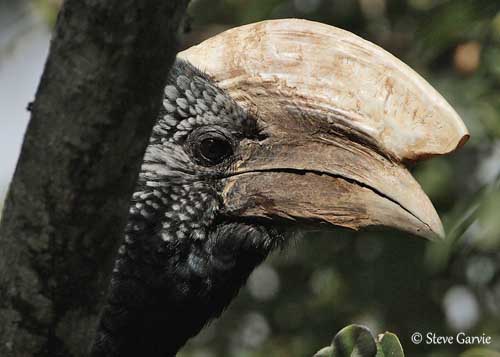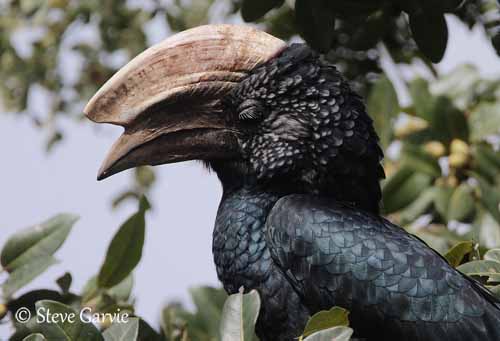
Fr: Calao à joues argent
All : Silberwangen-Hornvogel
Esp: Cálao Cariplateado
Ital: Bucero guanceargentate
Nd: Zilveroor-neushoornvogel
Sd: Silverkindad hornkorp
Photographer:
Steve Garvie
RAINBIRDER Photo galleries
Text by Nicole Bouglouan
Sources:
HANDBOOK OF THE BIRDS OF THE WORLD Vol 6 by Josep del Hoyo-Andrew Elliott-Jordi Sargatal - Lynx Edicions, 2001 - ISBN: 848733430X
BIRDS OF AFRICA SOUTH OF THE SAHARA by Ian Sinclair and Peter Ryan - Princeton University Press Princeton and Oxford - ISBN: 0691118159
ROBERTS BIRDS OF SOUTH AFRICA by G. R. Mc Lachlan and R. Liversidge – The Trustees of the John Voelcker Bird Book Fuund – ISBN: 0620031182
BirdLife International (BirdLife International)
Wikipedia, the free encyclopaedia
Silvery-cheeked Hornbill
Bycanistes brevis
Bucerotiforme Order – Bucerotidae Family
BIOMETRICS:
Length: 60-70 cm
Weight: M: 1260-1400 g – F: 1050-1450 g
DESCRIPTION:
The Silvery-cheeked Hornbill is a large black and white hornbill. It has long eyelashes to protect its eyes from sun and dust.
The adult male has white back, rump and uppertail-coverts. The tail is black with broad white terminal patch on outer rectrices. The wings are black with white carpal patch on the underwing. The breast and the belly are black. The undertail-coverts are white. The tail is like above.
On the head, the bird shows conspicuous silvery-grey face, whereas crown, nape, chin and throat are black.
The male has a large creamy casque on the curved, cream-colored bill. There is a yellowish line at bill base. The eyes are brown, surrounded by blue-black eye-ring. Legs and feet are greyish.

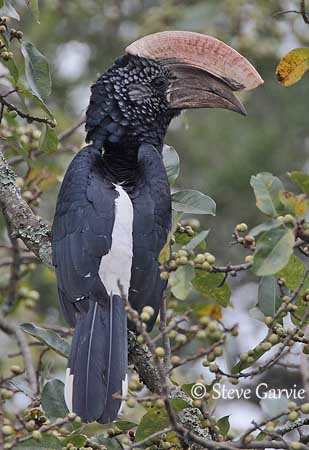
The female is similar in plumage but smaller, with smaller, greyer casque. She has pink eye-ring.
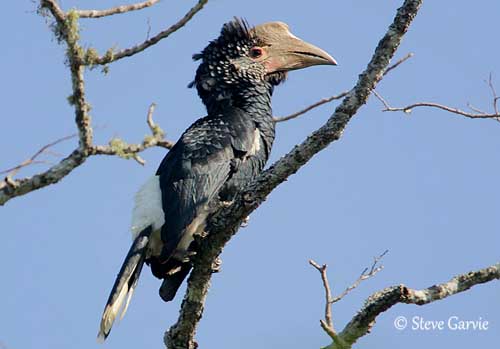
The juvenile has small bill and lacks the casque. It has not the silvery-grey cheeks.
VOICE: SOUNDS BY XENO-CANTO
The Silvery-cheeked Hornbill gives loud, nasal calls “quark, quark, quark”, and utters various sounds such as braying, howling and screeching sounds.
HABITAT:
The Silvery-cheeked Hornbill frequents montane and coastal forests, but also gallery forest, tall deciduous forest and woodland.
This species occurs at up to 2600 metres of elevation.
RANGE:
The Silvery-cheeked Hornbill is found from Ethiopian Highlands, SE Sudan and C Kenya, E and S Tanzania and Malawi, and C Mozambique to SE Zimbabwe.
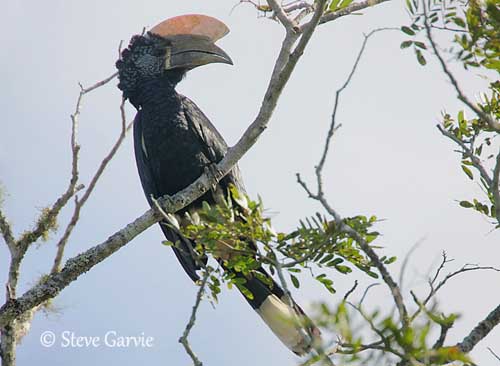
BEHAVIOUR:
The Silvery-cheeked Hornbill is mainly a fruit-eater, and consumes fruits from numerous plant species, and especially figs. It also catches small vertebrates, young birds, lizards, centipedes, insects and spiders.
It catches some preys while flying, but it forages primarily among the foliage. It may come to the ground for feeding. It rarely drinks. Its frugivorous diet provides it the necessary water.
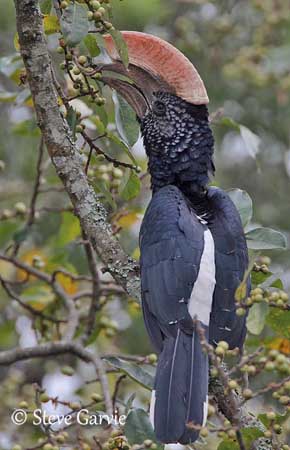
It can be found in pairs and even in flocks. They are fairly gregarious and roost communally in large flocks of up to 200 birds. They often return at night to the same roost-site.
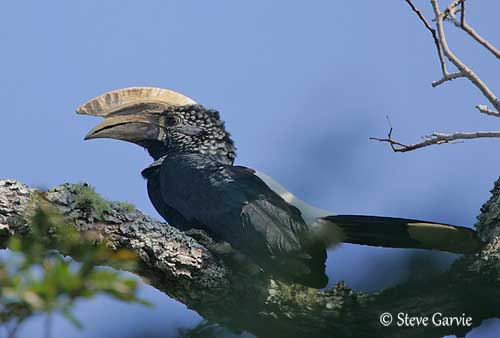
Some courtship displays are observed in Bycanistes species, such as repeated jumping back and forth by the male over the female. They breed in cavities where the female remains during the incubation and most part of the nesting period.
The entrance is sealed by the female, assisted by the male which sometimes brings lumps of mud in its bill tip. It also may swallow soil, and then it forms sticky pellets in its gullet with the saliva. It regurgitates these pellets to the female and she uses them to seal the vertical slit.
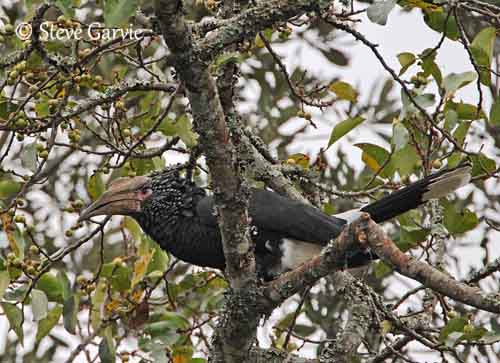
The Silvery-cheeked Hornbill appears to be resident in its range, but it performs long flights related to availability of fruiting trees. Nomadic flocks are formed mainly during the dry non-breeding season.
This species is vagrant in NE Zambia and NE South Africa.
FLIGHT:
The Silvery-cheeked Hornbill has straight and undulating flight, with periods of gliding every 4-5 wing-beats. During the flight, the wings produce a loud soughing noise.
REPRODUCTION:
The breeding season varies according to the range. This species breeds as monogamous pairs.
The Silvery-cheeked Hornbill nests in natural cavity in tree, between 7 and 25 metres above the ground. As in numerous hornbill species, both sexes seal the entrance into a vertical slit with mud pellets formed by the male.
It feeds the female with regurgitated fruits at nest, through the slit. There are about 24 visits per day.
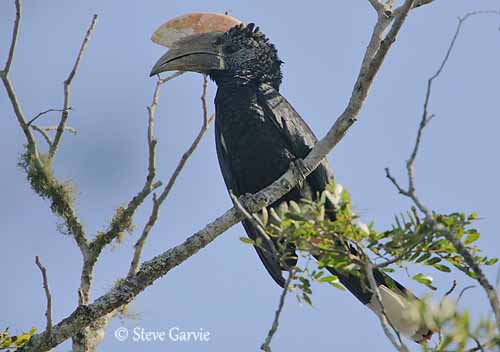
The female lays 1-2 white eggs, and incubates during 40 days. The chicks have pink skin at hatching, becoming dark grey some days later.
The female moults all flight feathers and rectrices while she is in the nest. She remains with the chicks until they fledge, about 77-80 days after hatching.
The whole nesting cycle lasts between 107 and 138 days.
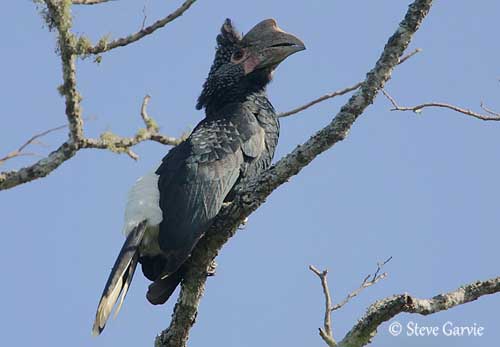
DIET:
The Silvery-cheeked Hornbill feeds primarily on fruits from more than 26 plant genera. It also takes small vertebrates, young birds and nest contents, lizards, centipedes, insects and spiders.
It forages mainly among the foliage and sometimes on the ground.
PROTECTION / THREATS / STATUS:
The Silvery-cheeked Hornbill is locally common but patchily distributed. This species is vulnerable to deforestation, but can use several types of habitats.
The populations are not currently threatened.
